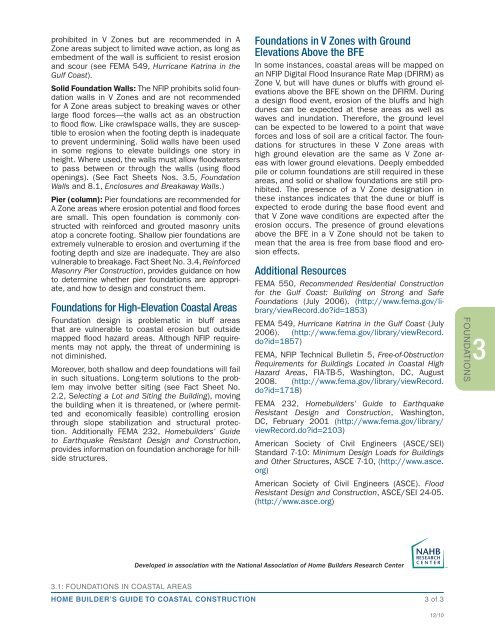FEMA P-499: Home Builder's Guide to Coastal Construction
FEMA P-499: Home Builder's Guide to Coastal Construction
FEMA P-499: Home Builder's Guide to Coastal Construction
Create successful ePaper yourself
Turn your PDF publications into a flip-book with our unique Google optimized e-Paper software.
prohibited in V Zones but are recommended in A<br />
Zone areas subject <strong>to</strong> limited wave action, as long as<br />
embedment of the wall is sufficient <strong>to</strong> resist erosion<br />
and scour (see <strong>FEMA</strong> 549, Hurricane Katrina in the<br />
Gulf Coast).<br />
Solid Foundation Walls: The NFIP prohibits solid foundation<br />
walls in V Zones and are not recommended<br />
for A Zone areas subject <strong>to</strong> breaking waves or other<br />
large flood forces—the walls act as an obstruction<br />
<strong>to</strong> flood flow. Like crawlspace walls, they are susceptible<br />
<strong>to</strong> erosion when the footing depth is inadequate<br />
<strong>to</strong> prevent undermining. Solid walls have been used<br />
in some regions <strong>to</strong> elevate buildings one s<strong>to</strong>ry in<br />
height. Where used, the walls must allow floodwaters<br />
<strong>to</strong> pass between or through the walls (using flood<br />
openings). (See Fact Sheets Nos. 3.5, Foundation<br />
Walls and 8.1, Enclosures and Breakaway Walls.)<br />
Pier (column): Pier foundations are recommended for<br />
A Zone areas where erosion potential and flood forces<br />
are small. This open foundation is commonly constructed<br />
with reinforced and grouted masonry units<br />
a<strong>to</strong>p a concrete footing. Shallow pier foundations are<br />
extremely vulnerable <strong>to</strong> erosion and overturning if the<br />
footing depth and size are inadequate. They are also<br />
vulnerable <strong>to</strong> breakage. Fact Sheet No. 3.4, Reinforced<br />
Masonry Pier <strong>Construction</strong>, provides guidance on how<br />
<strong>to</strong> determine whether pier foundations are appropriate,<br />
and how <strong>to</strong> design and construct them.<br />
Foundations for High-Elevation <strong>Coastal</strong> Areas<br />
Foundation design is problematic in bluff areas<br />
that are vulnerable <strong>to</strong> coastal erosion but outside<br />
mapped flood hazard areas. Although NFIP requirements<br />
may not apply, the threat of undermining is<br />
not diminished.<br />
Moreover, both shallow and deep foundations will fail<br />
in such situations. Long-term solutions <strong>to</strong> the problem<br />
may involve better siting (see Fact Sheet No.<br />
2.2, Selecting a Lot and Siting the Building), moving<br />
the building when it is threatened, or (where permitted<br />
and economically feasible) controlling erosion<br />
through slope stabilization and structural protection.<br />
Additionally <strong>FEMA</strong> 232, <strong>Home</strong>builders’ <strong>Guide</strong><br />
<strong>to</strong> Earthquake Resistant Design and <strong>Construction</strong>,<br />
provides information on foundation anchorage for hillside<br />
structures.<br />
3.1: FOUNDATIONS IN COASTAL AREAS<br />
HOME BUILDER’S GUIDE TO COASTAL CONSTRUCTION<br />
Foundations in V Zones with Ground<br />
Elevations Above the BFE<br />
In some instances, coastal areas will be mapped on<br />
an NFIP Digital Flood Insurance Rate Map (DFIRM) as<br />
Zone V, but will have dunes or bluffs with ground elevations<br />
above the BFE shown on the DFIRM. During<br />
a design flood event, erosion of the bluffs and high<br />
dunes can be expected at these areas as well as<br />
waves and inundation. Therefore, the ground level<br />
can be expected <strong>to</strong> be lowered <strong>to</strong> a point that wave<br />
forces and loss of soil are a critical fac<strong>to</strong>r. The foundations<br />
for structures in these V Zone areas with<br />
high ground elevation are the same as V Zone areas<br />
with lower ground elevations. Deeply embedded<br />
pile or column foundations are still required in these<br />
areas, and solid or shallow foundations are still prohibited.<br />
The presence of a V Zone designation in<br />
these instances indicates that the dune or bluff is<br />
expected <strong>to</strong> erode during the base flood event and<br />
that V Zone wave conditions are expected after the<br />
erosion occurs. The presence of ground elevations<br />
above the BFE in a V Zone should not be taken <strong>to</strong><br />
mean that the area is free from base flood and erosion<br />
effects.<br />
Additional Resources<br />
<strong>FEMA</strong> 550, Recommended Residential <strong>Construction</strong><br />
for the Gulf Coast: Building on Strong and Safe<br />
Foundations (July 2006). (http://www.fema.gov/library/viewRecord.do?id=1853)<br />
<strong>FEMA</strong> 549, Hurricane Katrina in the Gulf Coast (July<br />
2006). (http://www.fema.gov/library/viewRecord.<br />
do?id=1857)<br />
<strong>FEMA</strong>, NFIP Technical Bulletin 5, Free-of-Obstruction<br />
Requirements for Buildings Located in <strong>Coastal</strong> High<br />
Hazard Areas, FIA-TB-5, Washing<strong>to</strong>n, DC, August<br />
2008. (http://www.fema.gov/library/viewRecord.<br />
do?id=1718)<br />
<strong>FEMA</strong> 232, <strong>Home</strong>builders’ <strong>Guide</strong> <strong>to</strong> Earthquake<br />
Resistant Design and <strong>Construction</strong>, Washing<strong>to</strong>n,<br />
DC, February 2001 (http://www.fema.gov/library/<br />
viewRecord.do?id=2103)<br />
American Society of Civil Engineers (ASCE/SEI)<br />
Standard 7-10: Minimum Design Loads for Buildings<br />
and Other Structures, ASCE 7-10, (http://www.asce.<br />
org)<br />
American Society of Civil Engineers (ASCE). Flood<br />
Resistant Design and <strong>Construction</strong>, ASCE/SEI 24-05.<br />
(http://www.asce.org)<br />
Developed in association with the National Association of <strong>Home</strong> Builders Research Center<br />
3 of 3<br />
12/10<br />
FOUNDATIONS<br />
3


